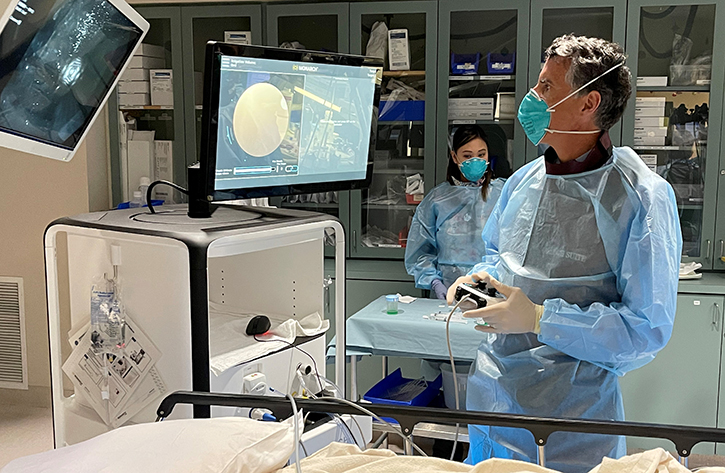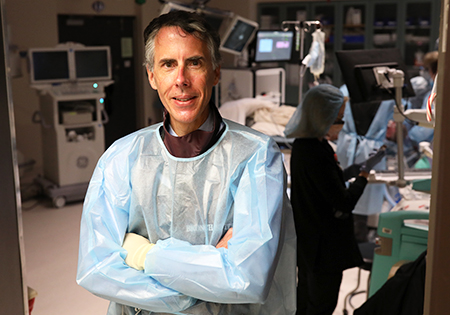New technology can help diagnose lung cancers earlier, more accurately
Cancer

St. Joseph’s/Candler adds the Monarch Platform to its arsenal of robotic technology
There’s new technology at St. Joseph’s/Candler that has familiar features but additional functionality to offer even more benefits to the patient.
The Monarch Platform, created by Auris Health, is the latest in robotic technology to diagnose lung cancer. Using robotic bronchoscopy, it’s now possible to enable earlier and more acute diagnosis of lung cancer while limiting false positives, false negatives and potential side effects.
“St. Joseph’s/Candler has always been at the forefront of technology,” says Dr. M. Douglas Mullins, pulmonologist at Southeast Lung Associates and member of the thoracic clinical effectiveness team at the Nancy N. and J.C. Lewis Cancer & Research Pavilion. “This is a whole new level. I’ve never been so enthusiastic about a new technology.”

The Monarch Platform integrates the latest advancements in robotics, software, data science and endoscopy, which is the use of small cameras and tools to enter the body through its natural openings. Dr. Mullins routinely performs bronchoscopy, in which a bronchoscope is put through a patient’s nose or mouth and guided into the lung’s airways looking for masses or blockages.
The Monarch robot still does that, but with more control and further reach.
“This is not a new procedure we are trying on patients,” Dr. Mullins says. “We have a long history of using frontline technology to navigate to places in the lung. What the Monarch robot does is give us more control. Tremendous control, actually.”
Using a familiar controller-like interface (think your child’s Xbox controller), Dr. Mullins is able to navigate the flexible robotic endoscope to the lung. Once the Monarch bronchoscope has gone as far as a traditional one can go, its camera is able to separate and extend even further into the airway. Biopsy tools can then extend through the camera.
Dr. Mullins navigates these tools using computer-assisted navigation that is based on 3D models of the patient’s own lung anatomy. This gives him continuous bronchoscope vision throughout the procedure.
“We had always been confined to the airways,” Dr. Mullins says. “Now we can go all the way out to the pleura, a thin layer of tissue located at the periphery of each lung.”
This enhanced capability for the physician provides many benefits to the patient including:
- Earlier diagnosis, which increases the chance of survival
- Improved patient outcomes
- Less false positives
- Less false negatives
- Reduces the need for a second procedure
- Fewer side effects
“When it’s smaller, we can get to it better than we’ve ever been able to do before,” Dr. Mullins says. “The precision of this technology gives me not just confidence in a positive diagnosis, but also to be confident in a negative or alternative diagnosis.”
The Monarch Platform is located in the Bronchoscopy Suite at Candler Hospital. As with all cancer diagnosis and treatments, your team of physicians, nurses and others will work with you to determine the best course of action to battle your lung cancer.
“Even stronger than the robot is our team, which has been working together for a long time,” Dr. Mullins says. “The Monarch Platform brings another element to what the best approach might be for any given patient.”